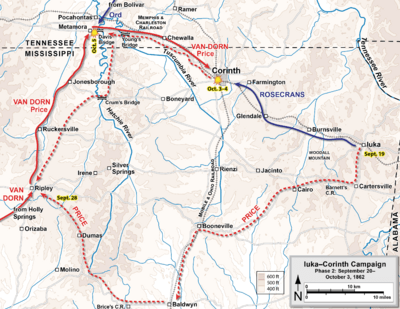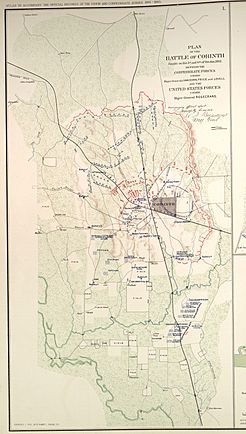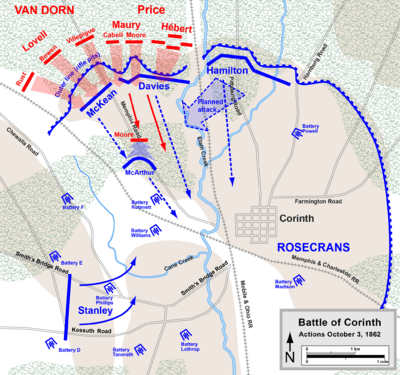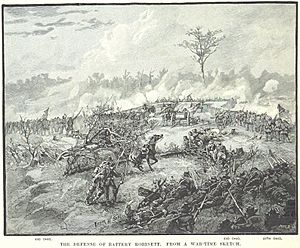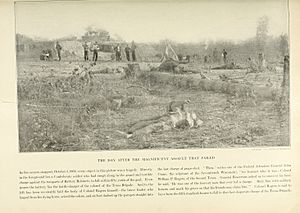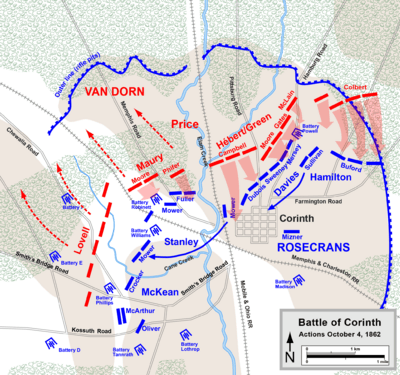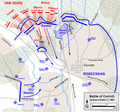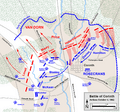Second Battle of Corinth facts for kids
Quick facts for kids Second Battle of Corinth |
|||||||
|---|---|---|---|---|---|---|---|
| Part of the American Civil War | |||||||
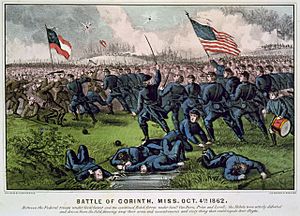 Battle of Corinth, Miss., October 4, 1862. Hand-colored lithograph by Currier and Ives, 1862 |
|||||||
|
|||||||
| Belligerents | |||||||
| Commanders and leaders | |||||||
| William Rosecrans Ulysses S. Grant |
Earl Van Dorn Sterling Price |
||||||
| Units involved | |||||||
| Army of the Mississippi | Army of West Tennessee | ||||||
| Strength | |||||||
| c. 23,000 | c. 22,000 | ||||||
| Casualties and losses | |||||||
| 2,520 (355 killed; 1,841 wounded; 324 captured/missing) |
4,233 (473 killed; 1,997 wounded; 1,763 captured/missing) |
||||||
The Battle of Corinth was a big fight during the American Civil War. It happened on October 3–4, 1862, in Corinth, Mississippi. This battle is also called the Second Battle of Corinth. It's named this way to tell it apart from an earlier siege of Corinth that year.
In this battle, the Union forces, led by Major General William Rosecrans, won. They defeated the Confederate army, which was led by Major General Earl Van Dorn. This was the second time Rosecrans beat a Confederate army in the Iuka-Corinth Campaign.
After the Battle of Iuka, Confederate Major General Sterling Price joined his army with Van Dorn's. Their combined force was called the Army of West Tennessee. Van Dorn, being the higher-ranking officer, took command. They marched towards Corinth, which was a very important train hub in northern Mississippi. The Confederates hoped to cut off Union supplies and then move into Middle Tennessee.
The battle started on October 3. Confederate soldiers pushed the U.S. Army out of their defensive ditches. These ditches were actually built by the Confederates earlier. The Confederates found a weak spot in the Union line. They kept pushing until the Union troops fell back to a stronger inner line of defenses.
On the second day, October 4, the Confederates attacked again. They faced heavy Union artillery fire. They stormed two strong points called Battery Powell and Battery Robinett. There was fierce hand-to-hand fighting. Some Confederate soldiers even got into the town of Corinth for a short time, but they were pushed back. After the U.S. Army took back Battery Powell, Van Dorn ordered his army to retreat. Rosecrans didn't chase them right away, so the Confederates were able to escape.
Contents
About the Battle of Corinth
What Happened Before?
In September 1862, Confederate General Braxton Bragg moved his army north into Kentucky. Union Major General Don Carlos Buell followed him from Nashville. Buell led the Army of the Ohio. Meanwhile, Confederate forces under Van Dorn and Price in northern Mississippi were supposed to move into Middle Tennessee. Their goal was to help Bragg. But they also needed to stop Buell from getting help from Major General Ulysses S. Grant's Army of the Tennessee.
Since the siege of Corinth ended that summer, Grant's army had been guarding supply lines. These lines were in western Tennessee and northern Mississippi. At the Battle of Iuka on September 19, Major General Sterling Price's Confederate army was defeated. Grant was in overall command, but Rosecrans led the actual fighting. Rosecrans was the commander of the Army of the Mississippi. Price had wanted to join his small army with Van Dorn's. They planned to cut off Grant's communication lines. But Rosecrans attacked first, making Price retreat from Iuka.
After Iuka, Grant set up his main office in Jackson, Tennessee. This was a good spot to talk to his commanders in Corinth and Memphis. Rosecrans went back to Corinth. Other Union divisions moved to Bolivar, Tennessee, northwest of Corinth. Grant's forces nearby included 12,000 men at Bolivar and 23,000 with Rosecrans at Corinth.
Price's army marched to Ripley and met Van Dorn on September 28. Van Dorn was the senior officer and took charge of their combined force. They had about 22,000 soldiers. They marched towards Pocahontas, Tennessee, on October 1. Grant wasn't sure where they were going. But when they camped at Chewalla on October 2, Grant realized Corinth was their target. The Confederates hoped to capture Corinth by surprise. They wanted to cut off Rosecrans from help. Then they planned to sweep into Middle Tennessee. Grant warned Rosecrans to get ready for an attack.
Around Corinth, about two miles from town, were old trenches. These had been built by Confederate General P. G. T. Beauregard earlier. Rosecrans's 23,000 men couldn't defend all these long lines. So, with Grant's approval, Rosecrans changed the defenses. He focused on protecting the town and the ammunition storage areas. These were near where the two railroads met.
Closer to the town was a stronger inner line of defenses called the Halleck Line. This line had several powerful batteries. Batteries are places where big guns are set up with strong earth walls for protection. These included Batteries Robinett, Williams, Phillips, Tannrath, and Lothrop. They were all connected by breastworks (low walls). Trees near Battery Robinett were cut down to create an abatis. An abatis is a barrier made of sharpened tree branches.
Rosecrans planned to use the old Confederate trenches as a first defense. His main force would then fight along the Halleck Line, about a mile from the town center. Their final stand would be around the batteries on College Hill. His soldiers had three days of food and plenty of ammunition. Van Dorn didn't know how strong the Union defenses were. Rosecrans had also called in two more divisions from Grant's army for help.
Who Fought in the Battle?
Union Forces
| Main Union Leaders |
|---|
|
Rosecrans's Army of the Mississippi was organized into divisions.
- The division of Brigadier General David S. Stanley had brigades led by Colonels John W. Fuller and Joseph A. Mower.
- The division of Brigadier General Charles S. Hamilton had brigades led by Brigadier Generals Napoleon B. Buford and Jeremiah C. Sullivan.
- The cavalry division of Colonel John K. Mizner had brigades led by Colonels Edward Hatch and Albert L. Lee.
- Two divisions were borrowed from the Army of the Tennessee. One was led by Brigadier General Thomas A. Davies. It had brigades led by Brigadier Generals Pleasant A. Hackleman and Richard J. Oglesby, and Colonel Silas D. Baldwin.
- The second borrowed division was led by Brigadier General Thomas J. McKean. It had brigades led by Brigadier General John McArthur and Colonels John M. Oliver and Marcellus M. Crocker.
Confederate Forces
| Main Confederate Leaders |
|---|
|
Van Dorn's combined Confederate Army of West Tennessee was organized like this:
- Price's Corps, also known as the Army of the West, had two divisions. One was led by Brigadier General Louis Hébert. The other was led by Brigadier General Dabney H. Maury.
- The 1st Division of the District of the Mississippi was led by Major General Mansfield Lovell. It had brigades led by Brigadier Generals Albert Rust, John B. Villepigue, and John S. Bowen. It also had a cavalry brigade and a special Zouave battalion.
The Battle Begins: October 3
On the morning of October 3, three of Rosecrans's divisions moved forward. They went into the old Confederate trenches north and northwest of town. McKean's division was on the left, Davies's in the center, and Hamilton's on the right. Stanley's division was kept ready in reserve south of town.
Van Dorn started his attack at 10 a.m. Lovell's division attacked McArthur's brigade from three sides. Van Dorn's plan was to attack from both sides. He hoped Rosecrans would move troops from his right side to help McKean. Then, Price would launch the main attack against the U.S. right side.
Lovell attacked Oliver's brigade strongly. As soon as he was fighting, Maury attacked Davies's left side. McArthur quickly sent four regiments to help Oliver. At the same time, Davies moved his line forward to the trenches. These movements created a gap between Davies and McKean. The Confederates forced their way through this gap around 1:30 p.m. The entire Union line fell back to within half a mile of their stronger defenses. They lost two cannons to the Confederates.
During this fighting, General Hackleman was killed. General Oglesby was seriously wounded, shot through the lungs. Around 3 p.m., Hamilton was told to turn and attack the Confederates' left side. But there was a misunderstanding, and it took too long to get into position. By sunset, it was too late to make the move. Van Dorn later said that if he had one more hour of daylight, he would have won. But if there was one more hour, Hamilton's fresh troops could have attacked the Confederate left and rear. This might have made Van Dorn retreat and avoided the second day of fighting.
By the end of October 3, the Confederates had the advantage. Rosecrans's troops had been pushed back everywhere. Night found almost all his army inside their strong defenses. Both sides were very tired from the fighting. The weather was hot, and water was hard to find. Many soldiers almost fainted from the effort. During the night, the Confederates slept very close to the Union defenses. Van Dorn changed his plans for the next day's attack. He decided to attack directly instead of trying fancy moves.
The Final Push: October 4
At 4:30 a.m. on October 4, the Confederates started firing cannons at the Union defenses. This lasted until after sunrise. When the cannons stopped, the U.S. troops got ready for an attack. But the attack was slow to come. Van Dorn had told Hébert to start fighting at daylight. The cannon fire was just to help Hébert get into position.
At 7 a.m., Hébert sent a message saying he was too sick to lead his division. Brigadier General Martin E. Green was ordered to take command and attack right away. It took almost two more hours before Green moved to attack. He formed his troops in a line and charged Battery Powell. The attack on Battery Powell was successful. The Confederates captured the cannons and scattered the Union troops.
Hamilton pushed back the attack on his position. Then he sent some of his men to help Davies. Davies rallied his soldiers, drove the Confederates out of the battery, and took back the cannons.
Maury's division had been fighting for a while before this. He heard the firing on his left. He knew Davies and Hamilton would be busy. So he ordered his division to move straight towards the town. His right side met strong resistance around 11 a.m. at Battery Robinett. This was a strong fort with a five-foot ditch and three large cannons. Fierce hand-to-hand fighting happened there. Maury had to retreat with many losses. Colonel William P. Rogers of the 2nd Texas was killed in this charge.
Phifer's brigade on the left had better luck. They pushed back Davies's left side and entered the town. But their success didn't last long. Part of Sullivan's brigade, which was held in reserve, charged the Confederates. The Confederates got confused in the narrow streets. As they fell back, they came under fire from Union cannons on both sides. This cross-fire completely routed them (made them run away in disorder).
Meanwhile, Lovell had been fighting with the Union left side near Battery Phillips. He was getting ready for a big attack. But before he was ready, he was ordered to send a brigade to help Maury. Soon after, he was told to position his troops to cover the army's retreat. At 4 p.m., Union reinforcements arrived from Jackson. These troops were led by Brigadier General James B. McPherson. But the Battle of Corinth was mostly over by 1 p.m., and the Confederates were already retreating.
What Happened After the Battle?
Rosecrans's army lost 2,520 soldiers at Corinth. This included 355 killed, 1,841 wounded, and 324 captured or missing. Van Dorn's army lost more, with 4,233 soldiers. This included 473 killed, 1,997 wounded, and 1,763 captured or missing.
Rosecrans didn't chase Van Dorn's army right away. Grant had told him to pursue them without delay. But Rosecrans didn't start marching until the morning of October 5. He said his troops needed rest. He also said the thick forests made it hard to move during the day and impossible at night. At 1 p.m. on October 4, when chasing them would have been most helpful, Rosecrans rode along his lines. He wanted to show his soldiers he was alive, as there was a rumor he had been killed. At Battery Robinett, he took off his hat and told his soldiers, "I stand in the presence of brave men, and I take my hat off to you."
Grant was upset. He wrote that a few hours of chasing the enemy on the day of the battle would have been worth more than any chase started the next day. Rosecrans went back to Corinth and was seen as a hero in the Northern newspapers. He was soon given command of the Army of the Ohio. This army was later renamed the Army of the Cumberland. He replaced Don Carlos Buell, who also failed to chase retreating Confederates after the Battle of Perryville.
Even though his army was badly beaten, Van Dorn escaped completely. He avoided Union troops sent by Grant later on October 5. He marched to Holly Springs, Mississippi. Van Dorn blamed his defeat on Hébert not starting the second day's fight on time. Still, he was replaced by Lieutenant General John C. Pemberton right after the battle. Many people in the South were angry about the many soldiers lost at Corinth. Van Dorn asked for an investigation to answer charges that he had left his wounded soldiers behind during the retreat. The investigation cleared him of all blame.
Protecting the Battlefield
The American Battlefield Trust and its partners have worked to save parts of the Corinth battlefield. They have protected about 791 acres (3.2 square kilometers) of the land where the battle took place.
Images for kids
-
Battle of Corinth, Miss., October 4, 1862. Hand-colored lithograph by Currier and Ives, 1862
-
Major General William Rosecrans
-
Major General Ulysses S. Grant
-
Brigadier General David S. Stanley
-
Brigadier General Charles S. Hamilton
-
Brigadier General Thomas A. Davies
-
Brigadier General Thomas J. McKean
-
Brigadier General John McArthur
-
Major General Sterling Price
See also
 In Spanish: Segunda Batalla de Corinth para niños
In Spanish: Segunda Batalla de Corinth para niños


